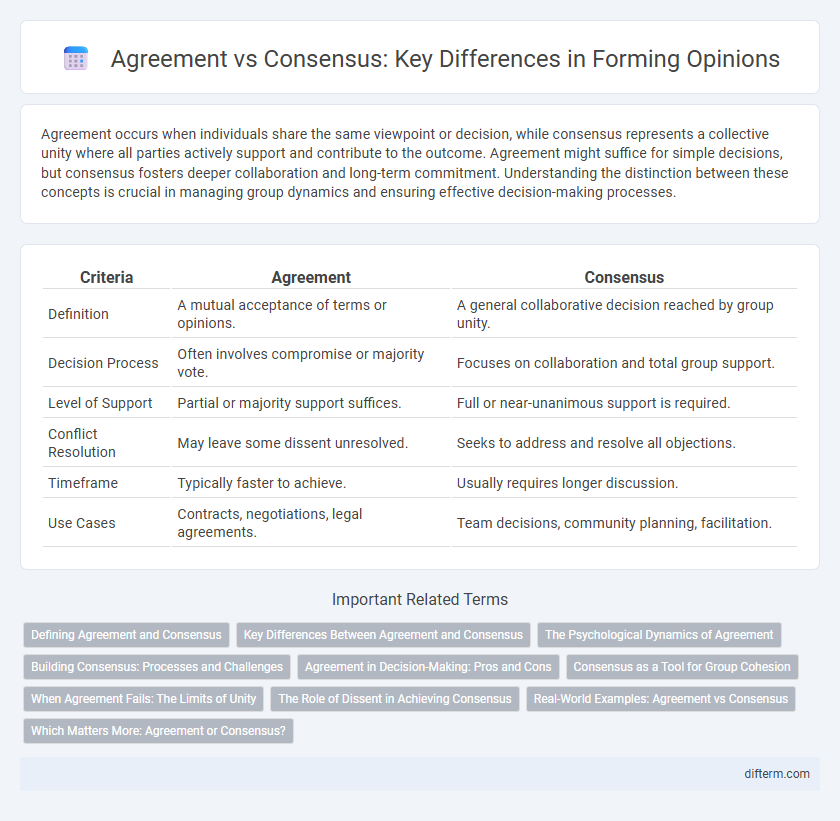Agreement occurs when individuals share the same viewpoint or decision, while consensus represents a collective unity where all parties actively support and contribute to the outcome. Agreement might suffice for simple decisions, but consensus fosters deeper collaboration and long-term commitment. Understanding the distinction between these concepts is crucial in managing group dynamics and ensuring effective decision-making processes.
Table of Comparison
| Criteria | Agreement | Consensus |
|---|---|---|
| Definition | A mutual acceptance of terms or opinions. | A general collaborative decision reached by group unity. |
| Decision Process | Often involves compromise or majority vote. | Focuses on collaboration and total group support. |
| Level of Support | Partial or majority support suffices. | Full or near-unanimous support is required. |
| Conflict Resolution | May leave some dissent unresolved. | Seeks to address and resolve all objections. |
| Timeframe | Typically faster to achieve. | Usually requires longer discussion. |
| Use Cases | Contracts, negotiations, legal agreements. | Team decisions, community planning, facilitation. |
Defining Agreement and Consensus
Agreement occurs when all parties express acceptance of a specific proposal or decision, reflecting a formal alignment of views or positions. Consensus, on the other hand, implies a deeper level of collective understanding and acceptance, often involving compromise to accommodate diverse perspectives and achieve mutual support. While agreement focuses on explicit acceptance, consensus emphasizes shared commitment and cooperative problem-solving.
Key Differences Between Agreement and Consensus
Agreement involves parties reaching a mutual understanding or acceptance of a specific point, often characterized by a formal or legal commitment. Consensus emphasizes collective collaboration, aiming for a decision that reflects the general approval and support of the entire group, even if individual preferences vary. Key differences include the level of unanimity required and the process duration, where consensus typically requires deeper discussion and engagement to ensure all voices are heard.
The Psychological Dynamics of Agreement
Agreement often stems from social conformity and the desire to avoid conflict, reflecting psychological mechanisms like cognitive dissonance reduction and the need for social acceptance. Consensus emerges through deeper mutual understanding and collaborative problem-solving, engaging processes such as perspective-taking and trust-building. These psychological dynamics influence how groups align on decisions, affecting the durability and authenticity of collective commitments.
Building Consensus: Processes and Challenges
Building consensus involves collaborative dialogue where diverse opinions are integrated to reach a shared agreement, prioritizing mutual understanding over mere majority rule. Effective consensus processes require active listening, trust-building, and addressing conflicting interests to align participants' goals. Challenges often arise from power dynamics, communication barriers, and differing values, necessitating skilled facilitation to achieve durable and inclusive outcomes.
Agreement in Decision-Making: Pros and Cons
Agreement in decision-making facilitates faster resolutions by aligning stakeholders with clear, defined outcomes, reducing ambiguity and enabling efficient implementation. However, rigid adherence to agreement can stifle diverse perspectives, potentially leading to suboptimal solutions and groupthink. Balancing agreement with inclusive dialogue helps optimize decision quality while maintaining decisiveness.
Consensus as a Tool for Group Cohesion
Consensus fosters group cohesion by ensuring active participation and shared commitment among members, which strengthens collective decision-making and trust. Unlike mere agreement, consensus requires addressing diverse perspectives and integrating them into a mutually acceptable solution, enhancing collaboration dynamics. This process not only aligns individual interests but also builds a resilient foundation for long-term group unity and effective teamwork.
When Agreement Fails: The Limits of Unity
When agreement fails, the limits of unity become evident as rigid attempts to align perspectives often lead to superficial consensus that masks underlying conflicts. True consensus requires deep engagement with diverse viewpoints, fostering authentic understanding rather than forced uniformity. Recognizing these boundaries allows groups to embrace pluralism, transforming potential division into collaborative strength.
The Role of Dissent in Achieving Consensus
Dissent plays a crucial role in achieving true consensus by challenging assumptions and encouraging diverse perspectives, which strengthens the final agreement. Without dissent, consensus risks becoming superficial, masking unresolved conflicts that can hinder long-term collaboration. Embracing constructive disagreement fosters innovation and ensures that decisions reflect a comprehensive understanding of all stakeholder concerns.
Real-World Examples: Agreement vs Consensus
Agreement often involves parties settling on specific terms despite underlying differences, as seen in international trade deals where countries accept compromises to finalize contracts. Consensus, exemplified by community-driven environmental initiatives, requires collective endorsement and reflects shared values beyond mere negotiation. Real-world examples illustrate that consensus fosters deeper commitment, while agreement secures practical resolutions more quickly.
Which Matters More: Agreement or Consensus?
Consensus often matters more than mere agreement because it reflects a deeper level of mutual understanding and collective commitment to a decision. Agreement can be superficial and fragile, while consensus ensures that all parties feel heard and are willing to support the outcome. Organizations leveraging consensus typically experience stronger cooperation and sustained implementation of decisions.
agreement vs consensus Infographic

 difterm.com
difterm.com